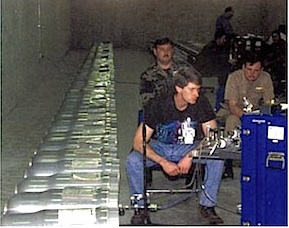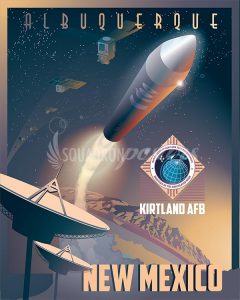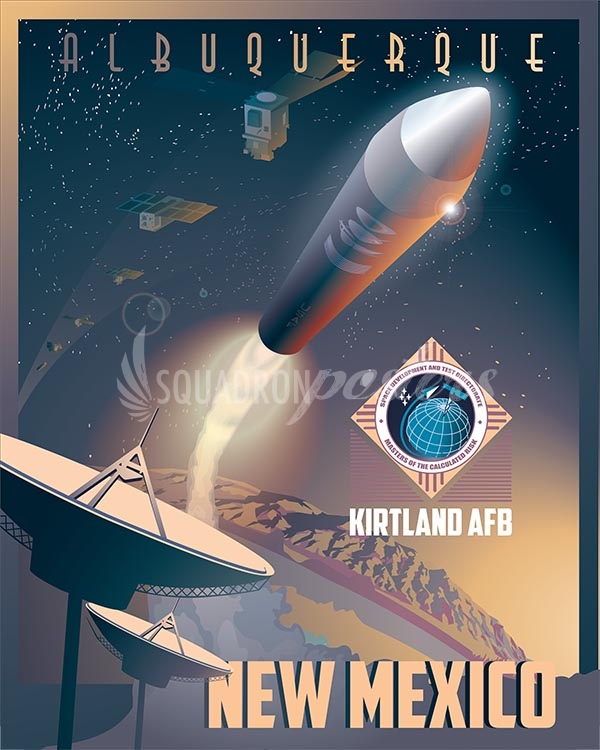"Ever since Gen. (Leslie) Groves established the Z Division here in September 1945, Albuquerque and Kirtland have been at the very heart and soul of America's nuclear weapon and nuclear security program - and remain so today."
- Frank G. Klotz, Administrator, NNSA. ABQJournal
Kirtland AFB Nuclear Weapons Complex
Kirtland Air Force Base, which abuts and shares some runways with the Albuquerque airport, has become an important nuclear weapons complex.
It hosts the Air Force's Nuclear Weapons Center, Sandia National Laboratories, and what is probably the nation's (and perhaps the world's) largest repository of nuclear weapons, estimated at up to 2,500 warheads.
Kirtland AFB is the third largest installation in Air Force Global Strike Command. (Others include Barksdale Air Force Base, Malmstrom Air Force Base, Minot Air Force Base, F. E. Warren Air Force Base.)
Air Force Nuclear Weapons Center
Kirtland is the home of the Air Force Materiel Command's Nuclear Weapons Center (NWC). The NWC's responsibilities include 'acquisition, modernization and sustainment of nuclear system programs for both the Department of Defense and Department of Energy'.
"Our mission is to deliver nuclear capabilities and winning solutions that warfighters use daily to deter our enemies and assure our allies," said Maj. Gen. Sandra Finan, commander, Air Force Nuclear Weapons Center. (ref)
 Kirtland Underground Munitions Maintenance and Storage Complex (KUMMSC)
Kirtland Underground Munitions Maintenance and Storage Complex (KUMMSC)
Activated in 1992, the largest storage facility for nuclear weapons in the nation and possibly the world; thought now to house up to 2500 warheads, most awaiting dismantlement; operated by the 898th Munitions Squadron, which reports to Air Force Global Strike Command. (ref) See this local TV report from 2006. (Left: Some of the hundreds of W-80 warheads stored at KUMMSC, Albuquerque, New Mexico.)
Sandia National Laboratories
Kirtland is also the home of Sandia National Laboratories. Sandia is a direct descendent of the Manhattan Project's engineering division that turned the first atomic devices into the deployable weapons that destroyed Hiroshima and Nagasaki. In July 1945, the forerunner of Sandia Laboratory, known as Los Alamos' 'Z' Division, was established at what is now Kirtland Air Force Base on the east edge of Albuquerque to handle nonnuclear components weapons development, testing, and bomb assembly for the Manhattan Project. Sandia became a separate lab in 1949... (read our profile of Sandia Labs here)
"We support U.S. deterrence policy by helping sustain, modernize, and secure the nuclear arsenal through our primary Nuclear Weapons mission." -Sandia statement
 Also at Kirtland:
Also at Kirtland:
- The Defense Nuclear Weapons School "the course teaches what happens with a nuclear terrorist attack and what entities respond"
- The Directed Energy Directorate"develops, integrates, and transitions science and technology for directed energy to include high-power microwaves, lasers, adaptive optics, imaging and effects to assure the preeminence of the United States in air and space"
- The Space Vehicle Directorate"develops and transitions high pay-off space technologies supporting the warfighter while leveraging commercial, civil and other government capabilities"
- The Airborne Laser System Program Office "develops, integrates, and transitions science and technology for directed energy to include high-power microwaves, lasers, adaptive optics, imaging and effects to assure the preeminence of the United States in air and space."
- The Operationally Responsive Space Office "a proactive step to adapt space capabilities to changing national security requirements"
- The School for Advanced Nuclear Deterrence Studies began classes in August 2015 at Kirtland; a year long program which will "consist of AFGSC officers, civilians, and joint officers who seek to become masters of the nuclear enterprise".
"SANDS is for the best and brightest of the command," said Lt. Gen. Stephen Wilson, former Air Force Global Strike Command commander and the driving force behind the school's creation. "It will draw on educators and curricula from across the nation. These students will be the 'Jedi Knights,' the really smart folks every combatant command wants." (ref) - Office of Secure Transportation - OST runs "unmarked 18-wheelers plying the nation's interstates and two-lane highways, logging 3 million miles a year hauling the most lethal cargo there is: nuclear bombs."
See a March 19, 2017 LA Times investigation: This Troubled, Covert Agency Is Responsible For Trucking Nuclear Bombs Across America Each Day
Kirtland Nuclear Weapons Complex Timeline
- 1945. Los Alamos' 'Z' Division, established at what is now Kirtland Field
- 1946. Strategic Air Command activated; SAC's 15th Air Force assumed operation of Kirtland Field.
- 1949. Z Division becomes Sandia Corp, and later, Sandia National Laboratories, the largest tenant in the Kirtland complex.
- 1949. Kirtland becomes headquarters for the newly created Special Weapons Command.
- 1971, Kirtland Field merges with Manzano and Sandia Base to the east, creating the sprawling military complex known as Kirtland Air Force Base
- 1992: Kirtland Underground Munitions Maintenance and Storage Complex (KUMMSC), the largest storage facility for nuclear weapons in the world, is activated at Kirtland.
- 1993. Previously managed as a national service by Lawrence Livermore Labs and AT&T, management of Sandia Laboratories is privatized under Martin Marietta.
- 1995. Martin Marietta merges with Lockheed to become Lockheed Martin
- 2006. Nuclear Weapons Center is created and becomes the parent organization at Kirtland AFB. The Nuclear Weapons Center (NWC) is Air Force Materiel Command's (AFMC) center of expertise for nuclear weapon systems.
- 2009. 498th Wing is 'redesignated' as 498 Nuclear Systems Wing, responsible for "integrating nuclear weapons and nuclear weapon system requirements and resources to deliver operational capabilities to the war-fighters".
- August 2015: The School for Advanced Nuclear Deterrence Studies begins courses at Kirtland. October 2015: Kirtland AFB 'repositioned' under Air Force Global Strike Command.
Updates
As New Mexicans Struggle, Sen. Heinrich is Proud of Nuclear Weapons Money
Sen. Heinrich is so proud of all of the nuclear weapons money in New Mexico. He is one of the chief congressional architects of expanded production of plutonium “pit” bomb cores and sits on the Senate Energy and Water Appropriations Subcommittee from where he can direct $$billions to the Sandia and Los Alamos Labs.
But during the Department of Energy’s long presence in the Land of Enchantment, according to Census Bureau data New Mexico has slid in per capita income from 32nd in 1959 to 47th in 2022. New Mexico has the most children living in poverty (30%) and is rated dead last in well-being of children and quality of public education. Finally, in a report that the Los Alamos Lab tried to suppress, six county governments surrounding Los Alamos County suffer a net economic loss from LANL.
In fiscal year 2024 DOE will spend $10 billion in New Mexico, 75% for core nuclear weapons research and production programs and 5% for dumping related radioactive wastes in our state. DOE’s budget is 6% greater than the entire operating budget of the State of New Mexico ($9.4 billion).
Senator Heinrich, please explain what good all that nuclear weapons money does for average New Mexicans, and not just for the privileged nuclear weapons enclaves.
For much more, please see nukewatch.org/new-mexico-americas-nuclear-colony
A spin on Kirtland Air Force Base’s (which shares runways with the ABQ International Airport) true mission from the ABQ Journal: “Air Force lab injects $2B into NM’s economy”
The Kirtland Air Force Lab is dedicated to militarizing space, not improving the lives of New Mexico citizens.
As stated by the Arms Control Association in an April 2021 article titled Apes on a Treadmill in Space:
“The United States should recognize that a pattern of continued militarization of space is insufficient to provide the stability on which its economy and its armed forces depend, so the tools of diplomacy and international law should be marshalled too.”

By Kevin Robinson-Avila / Journal Staff Writer – Albuquerque Journal abqjournal.com
Air Force Research Laboratory spending on space and “directed energy” technology like lasers and microwaves boosted the local economy by nearly $2 billion over the past three years, according to a new economic impact report.
Kirtland AFB Official News Paper
Find online here.
New NNSA complex near Kirtland gets green light
Construction on a new complex has been authorized by the U.S. Department of Energy’s National Nuclear Security Administration to replace 25 aged and dilapidated buildings currently located near Kirtland Air Force Base and Sandia National Laboratories.
60 yrs ago, the biggest nuclear weapon in the US arsenal was accidentally dropped 5 miles south of Albuquerque, New Mexico
On May 27, 1957, 5 miles south of the Albuquerque airport, a Mark 17 H-bomb (pictured at left) was accidentally dropped from a B-36 Peacemaker on it’s way to Kirtland AFB. The plutonium pit was not on board, but the fissile ‘spark plug’ detonated. Bits of the bomb, the biggest ever deployed by the US at 15-20 megatons, could still be found in the area (see picture below). But the authors of this 2010 report urged the collecting public to hurry, as the area would soon be covered over by a development called “Mesa del Sol”. And so it now is.(source: Carl Willis, “Albuquerque, Ground Zero”)



